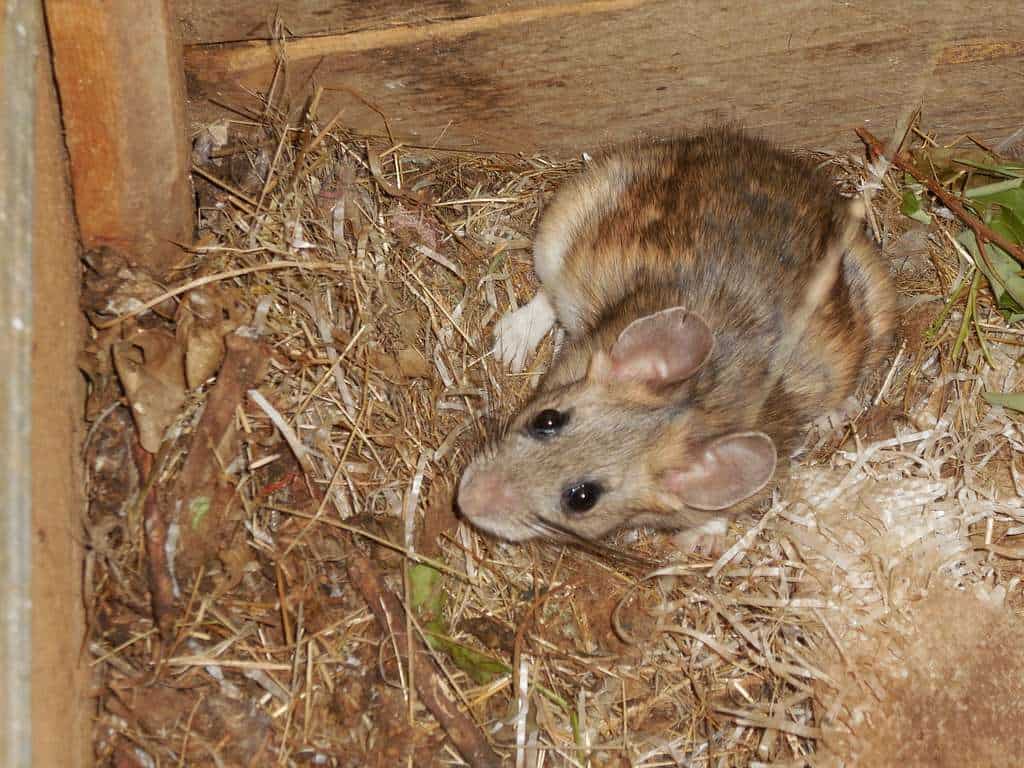Jump to:
Dealing with mice in your garden shed, wooden ones in particular can be a pesky problem. If overlooked, this can cause potential damage to your stored items and pose health risks. In this blog, we’ll explore the ins and outs of preventing and addressing mouse infestations in sheds. Read on and ensure your storage building remains a critter-free zone!
Understanding the Threat

(Image Credit: Wikimedia Commons)
Mice infestations in wooden sheds pose risks, both property damage and health concerns. These small rodents have a knack for chewing through various materials. This includes but is not limited to wood, cardboard, and electrical wires. If neglected, this can lead to potential structural damage and fire hazards. Beyond property threats, mice can transmit diseases through their droppings, urine, and bites. This, in turn, can pose health risks to shed occupants.
Recognising the signs of a mouse infestation is crucial. Keep an eye out for signs like:
- bite marks (such as on wooden beams, electrical wirings, or insulation materials)
- mouse droppings
- nests with shredded materials
- unusual smells
If you spot any of these, take action ASAP to prevent the problem from getting worse. Regularly inspect and clean your shed to catch these signs early on.
Identifying Vulnerabilities

To keep mice out of your shed, start by assessing potential entry points they might exploit. Check for gaps, cracks, or openings in walls, windows, and doors. Seal these entry points with caulk, such as this silicone and gun set, or weatherstripping. This technique can effectively create a barrier against unwelcome rodent guests. Additionally, inspect the foundation for any openings that mice could use for entry.
Ensure your shed remains clutter-free, as mice seek hiding spots in piles of debris. Store firewood away from the shed, as it can provide a cosy nesting spot. Keep food sources, such as birdseed or pet food, in sealed containers. Regular inspections and upkeep also play a role in keeping these critters at bay. With these considerations, you create a less inviting environment for mice.
Prevention Measures
Mice are adept at finding entry points into garden sheds, even the tiniest openings. Common openings include gaps around doors, cracks in walls, and holes in the roof. To fortify your storage shed, seal these potential access points. Use durable materials like steel wool, caulk, or weatherstripping. Conduct regular inspections and repair any damages.
Adopt proper storage practices by elevating items off the ground. You may use sealed containers and organise your belongings. This not only minimises nesting spots but also makes it tricky for mice to access food sources.
Explore natural deterrents like peppermint oil, which mice dislike. Place cotton balls soaked in this oil strategically around the shed. Alternatively, consider safe traps, such as catch-and-release or electronic traps. This approach effectively helps to control mice without resorting to harmful chemicals. Regularly check and reset traps to maintain an effective defence.
DIY Solutions

Looking for a practical and budget-friendly approach to keep your shed rodent-free? Consider crafting homemade mouse repellents. Follow this step-by-step guide for effective DIY solutions:
- Peppermint oil spray: Mix peppermint oil with water and spray the solution around potential entry points. Mice dislike the scent, acting as a natural deterrent.
- Vinegar and baking soda paste: Create a paste using equal parts vinegar and baking soda. Apply it to areas where mice may frequent, as the scent is known to repel them.
- Bay leaves in corners: Place bay leaves in shed corners and storage areas. The strong aroma is displeasing to mice, deterring them from nesting.
- Cloves in sock sachets: Fill socks with whole cloves and hang them in vulnerable areas. The scent of cloves serves as a deterrent, keeping mice at bay.
For cost-effective DIY projects, consider sealing cracks with steel wool. Stuff steel wool into gaps or holes as mice find it difficult to chew through. Next, build raised platforms for storage to minimise potential hiding spots. This also makes it challenging for mice to reach your belongings.
Cleaning and Maintenance
The importance of cleanliness cannot be overstated. Otherwise, clutter and debris create ideal hiding spots for mice. Regularly sweep the shed floor, dispose of trash, and declutter to minimise nesting sites. Clean up spilt food, seeds, or crumbs that may attract mice.
Next, implement regular maintenance routines to fortify your shed against mice. Seal any cracks, gaps, or holes in the walls, floor, and roof to eliminate entry points. Check doors and windows for proper sealing, and repair any damages before they get worse. Conduct routine inspections for signs of wear and tear, addressing them right away.
Keep your shed clean to prevent mice and make it a safer place for your belongings!
Round-up
To sum up, keeping mice away from your shed requires being watchful and taking action. Seal entry points, store items properly, and use DIY or commercial solutions. A clean and well-maintained shed prevents mice and also keeps your belongings safe. Follow these tips for a critter-free and secure shed!
When it’s time for a new shed, Garden Buildings Direct is your one-stop shop! Discover our diverse selection of garden sheds, featuring pressure-treated sheds. Explore now for your perfect storage building investment!
Up next on your reading list: Rats in the Garden: Advice, Control and Elimination










